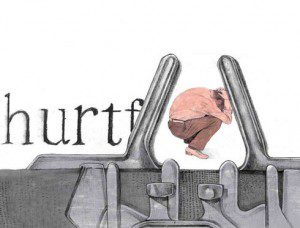The Journalism Responsibility Unit
The Ontario Court of Appeal’s decision to allow a new libel defence, “responsible journalism,” opens the door for more stories in the public interest—or does it?

Will “responsible journalism” provide more protection to journalists as a libel defence, or will it give them license to attack subjects in the name of truth?
Illustration by: Eric Juan
Libel plaintiff lawyer Ronald F. Caza was arguing a motion in an Ottawa court when he received the email from his junior lawyer, Jeff Saikaley. Caza knew exactly when the decision would be made. With 30 seconds of downtime, he checked his BlackBerry and read an email saying something along the lines of, “New defence recognized by Court of Appeal but appeal dismissed.”
Last spring, Caza represented Danno Cusson, an Ontario Provincial Police constable who, after participating in the search and rescue operations following the September 11, 2001 attacks in New York, had been written about in theOttawa Citizen in a negative light. Cusson sued the Citizen, the Ottawa Citizen Group Inc., Southam Publications (a CanWest Global Communications company) and his OPP Staff Sergeant Penny Barager for defamation. The jury found that two of three stories about Cusson were defamatory, and damages were awarded. The defence then filed an appeal.
The day Caza received the email, he made his way back to the office at the law firm of Heenan Blaikie and logged onto his computer to read the decision in detail. The plaintiff lawyer was satisfied: the appeal had been dismissed and he’d won his case. But he was wary-he may have won the Cusson battle but lost the libel war. He decided the new ruling was a loss for victims of libel.
Ontario Court of Appeal Justice Robert Sharpe’s decision, issued November 13, allows for a new defence, “responsible journalism” in the public interest, when media companies are sued for defamation. “Truth” (a defence that proves the truth behind a statement), “fair comment” (presenting a statement that’s clearly an opinion as an opinion), and “privilege to publish” (giving public access to courts, Parliament and the proceedings of other public institutions), have been other major defences used in libel cases in Canada. The defence of responsible journalism can be used when journalists are able to produce evidence of a reasonable amount of research that proves their public interest stories are accurate based on their “responsible journalism.” The existing “truth” defence requires the defence to prove what the journalist says is true, whereas “responsible journalism” is about sources, research and public interest. The ruling seems to imply that the media have been emboldened to pursue tough stories in the public interest, but no two lawyers can agree on exactly what it will mean for journalism.
Some attorneys are enthusiastic and in favour of making our libel laws consistent with other English-speaking democracies, such as England and Australia. Others see the ruling as a vague new defence that means nothing. And then there’s Caza, who says, “This decision is one of the biggest changes in the law of defamation in the last 50 years.” Believing it makes for an uneven playing field, he says, “The question now is, ‘Did they exercise responsible journalism? The issue of truth is no longer determinative of what the end result of the litigation will be when it is a matter determined to be of public importance.”
Caza thinks the decision creates a better defence for Canadian media because the Ontario Court of Appeal has reduced the fear and likelihood of being sued successfully for defamation. “Newspapers will be allowed to publish lies and will not be accountable if it’s on public interest issues,” says Caza, “as long as they exercise responsible journalism.”
Toronto Star lawyer Bert Bruser thinks Sharpe’s ruling makes for a dramatic change in libel law as well, but he’s much more optimistic. He says Canadian media have been operating under rules long discarded by other western democracies, including the United States, England and Australia. “Finally,” he says, “the Ontario Court of Appeal has determined that our law should change. For the media it’s a relief that we’ve finally gotten ourselves into this century.”
Peter Jacobsen, a lawyer for The Globe and Mail, was an intervener on behalf of the Globe, the Canadian Newspaper Association and Ad IDEM/Canadian Media Lawyers Association, in the Cusson appeal. He also has a more optimistic view of the decision, saying the ruling gives newsrooms some assurance when getting public interest stories out. He also likes the fact that the plaintiff can no longer lie back in the weeds and say nothing. “It recognizes responsible journalism at a high value,” he says. “It gives journalists a defence.”
Jacobsen has been using the responsible journalism defence for a while, anticipating it would be approved. “For the most part,” he says, “journalists do practice responsible journalism-it’s going to benefit a lot of them.” He believes guidelines for responsible journalism can be found just as easily as other professions. “We have a lot of guidance from schools of journalism, from professors, from practitioners,” he says. “You go to medical schools, you call practicing doctors, you find out the standards-how is it any different than that?”
Journalists such as the Toronto Star‘s Jim Rankin think the new defence improves the quality of journalism because it brings a sense of security to the endeavour. It will help to get more stories in the public interest out with less apprehension. “It has the impact of improving the quality of journalism across the country,” he says. “It stresses the importance of responsibility in reporting.”
Former Toronto Sun lawyer and current Sun media columnist Alan Shanoff isn’t so sure, saying he doesn’t think any significant changes in court outcomes will occur. The only practical purpose it might serve, he suggests, is to make plaintiffs more reluctant to sue and reduce some amounts of legal settlements. He views it as less of a triumph for journalism and more of a victory for the common law of defamation. He also believes the new defence will only lengthen trials and do nothing to improve the quality of journalism. “We’re inviting the courts into the newsroom,” he says. “Judges and juries are becoming editors.”
Lawyer Charles Campbell of Iler Campbell says the main problem is who gets to define the term “responsible journalism,” and exactly how is it defined. But he also thinks the decision signals a shift in the way Canadians perceive journalism in the public interest. He cites an old libel decision from 1961 to illustrate his point. The case pitted the Globe against Harold C. Banks, with the paper reporting in an editorial that Banks, a union vice-president, was corrupt. At trial, the Globe’s defence was that in was in the public interest to report on Banks’s control of the Seafarers International Union. The paper lost its case then, but Campbell thinks “it would have been decided differently under the new test. If the Globe does some reasonable research,” he says, “and presents some indices of corruption, and then gives Banks the chance to respond, then they could go ahead and publish it. There’s the kind of illustration,” he concludes, “that nowadays we want newspapers to do that kind of crusading and investigation.”
Campbell also thinks the ruling could cause a shift in what journalism is about in the first place. “Is journalism about getting at the truth,” he asks, “or about what people say about people?”
by Chloë Tse
Chloë Tse was the Front of Book Editor for the Summer 2008 issue of the Ryerson Review of Journalism.










































